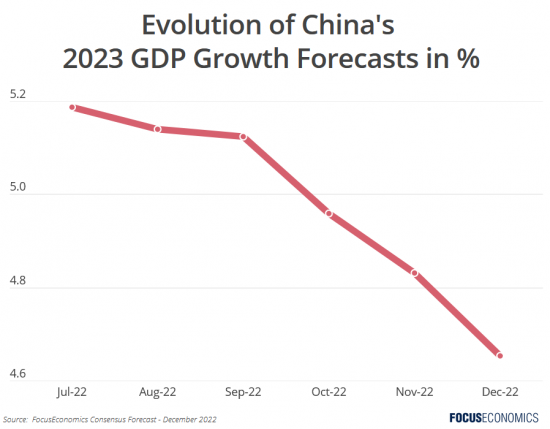In the last few weeks, Covid-19 cases in China have surged to record highs, with pandemic restrictions rising to affect around 25% of the country’s GDP by late November according to analysts at Nomura, above the previous peak of 21% reached in April when Shanghai was under lockdown. The toughening of pandemic measures at a local level ran counter to the 20-point central-government directive from mid-November, which had hinted at an easing of restrictions. The latest developments have hit the economy: Survey data suggests that economic activity in the manufacturing and services sectors declined in November at the fastest pace since April/May.
However, by spurring the worst civil unrest in decades, the lockdowns may ironically have propitiated the end of the government’s zero-tolerance Covid-19 policy; at the end of November several cities abruptly lifted restrictions, and the country’s vice premier declared that the pandemic was entering a “new situation” characterized by less severe illness. Reuters reported that a further relaxation of pandemic protocols will be announced in the coming days. The government’s calculus could now be shifting to the view that the economic and reputational damage from maintaining the zero-tolerance stance is greater than the fallout from the inevitable rise in deaths that a shift to living with the virus will bring.
For now, all eyes will be on whether incipient steps to open up become more comprehensive in the coming months. This would undoubtedly help the economy in the medium term, but short-run output could still be disrupted as the virus ripples through the population, leading to caution among consumers, worker absenteeism and a saturation of the healthcare system. The combination of the use of less-potent autochthonous vaccines, a low vaccination rate among the elderly and a low number of intensive-care units presages a high death rate from a rapid lifting of Covid-19 restrictions.

Over the last several months, our analysts have sharply downgraded China’s GDP growth forecasts. Following an expected 3.2% expansion this year, the Consensus is for output to rise 4.7% in 2023, which would be one of the slowest rates in decades. Future forecasts hinge on the duration and extent of the government’s Covid-19 restrictions.
-
Insights from Our Analyst Network
On the outlook, analysts at Nomura said:
“We believe [Vice Premier] Sun’s speech, in addition to the notable easing of Covid control measures in Guangzhou yesterday, sends yet another strong signal that the zero-Covid policy will end within the next few months. These two events perhaps point to the beginning of the end of zero Covid. Nevertheless, we caution that the path to “living with Covid” may still be slow, costly and bumpy. Covid might be more infectious in winter, switching the narrative takes time and a surge of infections and disruptions may be inevitable. The probability of our positive scenario (surging cases now + faster reopening before March 2023) has increased slightly.”
Regarding the government’s Covid-19 strategy, analysts at the EIU said:
“China’s zero-covid policy now poses challenges not only to the healthcare system and the economy, but also to governance and the fiscal outlook at grassroots level. We thus expect the central government to more forcefully prioritise medical resources for vulnerable groups and severe cases, rather than quarantining mild and asymptomatic cases. Key policy shifts could be revealed at a forthcoming Politburo meeting or at the Central Economic Work Conference in December, but meaningful change may not materialise until 2023 and local co-ordination on a unified reopening will take longer.”
Disclaimer: The views and opinions expressed in this article are those of the authors and do not necessarily reflect the opinion of FocusEconomics S.L.U. Views, forecasts or estimates are as of the date of the publication and are subject to change without notice. This report may provide addresses of, or contain hyperlinks to, other internet websites. FocusEconomics S.L.U. takes no responsibility for the contents of third party internet websites.